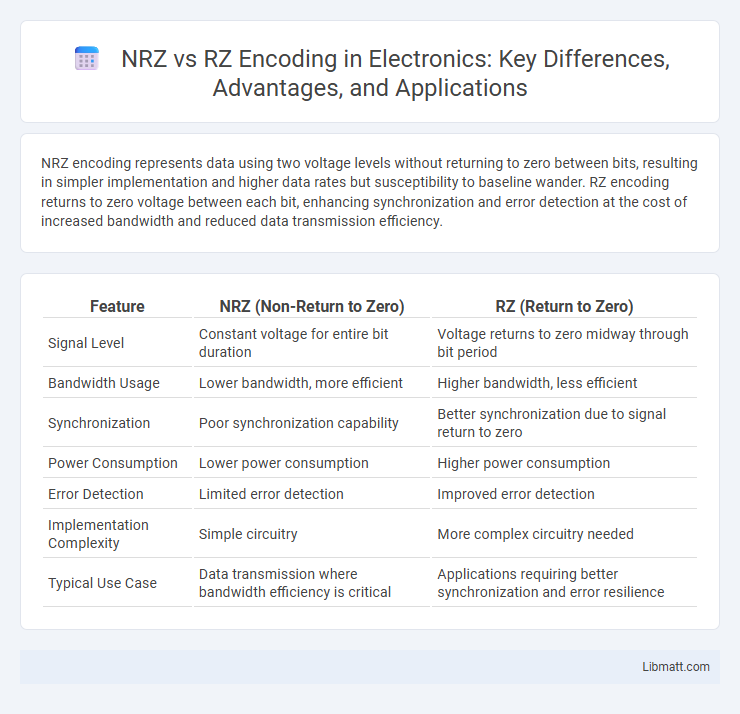NRZ encoding represents data using two voltage levels without returning to zero between bits, resulting in simpler implementation and higher data rates but susceptibility to baseline wander. RZ encoding returns to zero voltage between each bit, enhancing synchronization and error detection at the cost of increased bandwidth and reduced data transmission efficiency.
Table of Comparison
| Feature | NRZ (Non-Return to Zero) | RZ (Return to Zero) |
|---|---|---|
| Signal Level | Constant voltage for entire bit duration | Voltage returns to zero midway through bit period |
| Bandwidth Usage | Lower bandwidth, more efficient | Higher bandwidth, less efficient |
| Synchronization | Poor synchronization capability | Better synchronization due to signal return to zero |
| Power Consumption | Lower power consumption | Higher power consumption |
| Error Detection | Limited error detection | Improved error detection |
| Implementation Complexity | Simple circuitry | More complex circuitry needed |
| Typical Use Case | Data transmission where bandwidth efficiency is critical | Applications requiring better synchronization and error resilience |
Introduction to NRZ and RZ Encoding
NRZ (Non-Return to Zero) encoding represents digital data using two distinct voltage levels without returning to zero between bits, optimizing bandwidth efficiency and simplifying receiver design. RZ (Return to Zero) encoding, however, includes a return to zero voltage level within each bit period, reducing synchronization errors at the expense of increased bandwidth usage. Understanding the trade-offs between NRZ and RZ encoding is crucial for optimizing your digital communication system's performance.
Fundamentals of NRZ Encoding
NRZ (Non-Return-to-Zero) encoding represents binary data by maintaining the signal level throughout the entire bit interval, with a high voltage for a binary 1 and a low voltage for a binary 0. This method simplifies the transmission process by avoiding unnecessary transitions, making NRZ a fundamental scheme in digital communication. Your data accuracy relies on consistent timing synchronization since NRZ lacks inherent clock information.
Fundamentals of RZ Encoding
RZ (Return-to-Zero) encoding represents binary data by switching the signal to a high or low state within the first half of the bit interval and returning to zero for the remainder. This method provides clear timing information through signal transitions, reducing synchronization errors in digital communication systems compared to NRZ (Non-Return-to-Zero) encoding. Understanding RZ encoding fundamentals helps you improve signal integrity and timing accuracy in high-speed data transmission.
Key Differences: NRZ vs RZ
NRZ (Non-Return-to-Zero) encoding maintains a constant voltage level for the entire bit duration, representing binary values without returning to zero between bits, which allows for higher data rates but can cause synchronization issues. RZ (Return-to-Zero) encoding, by contrast, returns to zero voltage halfway through each bit interval, providing better synchronization and error detection at the cost of reduced bandwidth efficiency. Understanding these key differences helps you choose the appropriate encoding scheme for your communication system's requirements in terms of data integrity and transmission speed.
Signal Waveform Comparison
NRZ encoding maintains a constant voltage level throughout the bit interval, representing binary 1s and 0s with distinct high and low signals, resulting in a straightforward, flat waveform. RZ encoding returns to a zero voltage level halfway through each bit interval, producing a waveform that includes transitions within the bit period, which helps with synchronization but consumes more bandwidth. The NRZ waveform is more bandwidth-efficient but susceptible to baseline wander and synchronization issues, while RZ's signal transitions improve timing recovery at the cost of increased spectral content.
Bandwidth Requirements Analysis
NRZ encoding requires less bandwidth compared to RZ encoding because it maintains signal levels throughout the bit interval, resulting in lower frequency components. RZ encoding, with its signal returning to zero mid-bit, doubles the fundamental frequency, effectively increasing the required bandwidth. You should consider NRZ for bandwidth-efficient applications and RZ when synchronization and error detection are prioritized despite higher bandwidth use.
Noise Immunity and Error Performance
NRZ (Non-Return-to-Zero) encoding offers higher spectral efficiency but is more susceptible to noise due to the lack of signal transitions within bit periods, leading to potential synchronization issues and increased error rates. RZ (Return-to-Zero) encoding improves noise immunity by incorporating a return to zero voltage level within each bit period, allowing better timing recovery and reduced bit error probability in noisy channels. Your choice between NRZ and RZ impacts overall error performance, with RZ typically providing greater resilience against interference in environments with significant noise.
Practical Applications of NRZ and RZ
NRZ (Non-Return-to-Zero) encoding is widely used in high-speed digital communication systems such as Ethernet and USB due to its simplicity and efficient bandwidth utilization. RZ (Return-to-Zero) encoding finds practical applications in optical fiber communication and clock recovery systems where signal synchronization is critical. Your choice between NRZ and RZ depends on factors like transmission distance, noise immunity, and timing accuracy requirements.
Advantages and Disadvantages
NRZ encoding offers simplicity and efficient bandwidth usage by maintaining a constant voltage level for each bit, which reduces signal transitions and power consumption. However, NRZ struggles with synchronization issues over long distances due to the lack of regular signal transitions, making error detection challenging. RZ encoding provides better synchronization with signal transitions in every bit, improving data integrity but requires double the bandwidth and higher power consumption compared to NRZ.
Choosing the Right Encoding Scheme
Choosing the right encoding scheme depends on factors such as signal bandwidth, synchronization needs, and error sensitivity. NRZ (Non-Return-to-Zero) offers higher data rates with simpler implementation but lacks inherent synchronization, making it less suitable for noisy channels. RZ (Return-to-Zero) provides better synchronization and error detection at the cost of increased bandwidth, impacting the efficiency of Your communication system.
NRZ vs RZ encoding Infographic

 libmatt.com
libmatt.com